Related Research Articles
Sobek was an ancient Egyptian deity with a complex and elastic history and nature. He is associated with the Nile crocodile or the West African crocodile and is represented either in its form or as a human with a crocodile head. Sobek was also associated with pharaonic power, fertility, and military prowess, but served additionally as a protective deity with apotropaic qualities, invoked especially for protection against the dangers presented by the Nile. Sobek has been famed for having been revered by the first female Pharaoh by the Nebty name Sat-Sekhem-Nebet-Tawy Sobekneferu, present both in the female Pharaoh's nomen, Sobekneferu, and her praenomen Kasobekre.

Hieratic is the name given to a cursive writing system used for Ancient Egyptian and the principal script used to write that language from its development in the third millennium BC until the rise of Demotic in the mid-first millennium BC. It was primarily written in ink with a reed pen on papyrus.
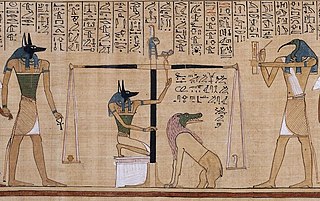
The Book of the Dead is an ancient Egyptian funerary text generally written on papyrus and used from the beginning of the New Kingdom to around 50 BC. The original Egyptian name for the text, transliterated r(ꜣ)w n(y)w prt m hrw(w), is translated as Book of Coming Forth by Day or Book of Emerging Forth into the Light. "Book" is the closest term to describe the loose collection of texts consisting of a number of magic spells intended to assist a dead person's journey through the Duat, or underworld, and into the afterlife and written by many priests over a period of about 1,000 years. Karl Richard Lepsius introduced for these texts the German name Todtenbuch, translated to English as Book of the Dead.
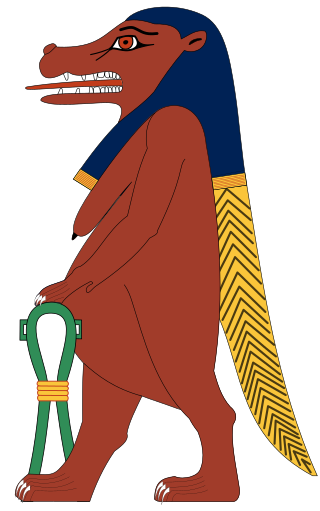
In Ancient Egyptian religion, Taweret is the protective ancient Egyptian goddess of childbirth and fertility. The name "Taweret" means "she who is great" or simply "great one", a common pacificatory address to dangerous deities. The deity is typically depicted as a bipedal female hippopotamus with feline attributes, pendulous female human breasts, the limbs and paws of a lion, and the back and tail of a Nile crocodile. She commonly bears the epithets "Lady of Heaven", "Mistress of the Horizon", "She Who Removes Water", "Mistress of Pure Water", and "Lady of the Birth House".

The Eye of Horus, also known as left wedjat eye or udjat eye, specular to the Eye of Ra, is a concept and symbol in ancient Egyptian religion that represents well-being, healing, and protection. It derives from the mythical conflict between the god Horus with his rival Set, in which Set tore out or destroyed one or both of Horus's eyes and the eye was subsequently healed or returned to Horus with the assistance of another deity, such as Thoth. Horus subsequently offered the eye to his deceased father Osiris, and its revitalizing power sustained Osiris in the afterlife. The Eye of Horus was thus equated with funerary offerings, as well as with all the offerings given to deities in temple ritual. It could also represent other concepts, such as the moon, whose waxing and waning was likened to the injury and restoration of the eye.

The Edwin Smith Papyrus is an ancient Egyptian medical text, named after Edwin Smith who bought it in 1862, and the oldest known surgical treatise on trauma. From a cited quotation in another text, it may have been known to ancient surgeons as the "Secret Book of the Physician".
Lake Moeris is an ancient artificially-fed endorheic lake in the northwest of the Faiyum Oasis, 80 km (50 mi) southwest of Cairo, Egypt. In prehistory, it was a freshwater lake, with an area estimated to vary between 1,270 km2 (490 sq mi) and 1,700 km2 (660 sq mi).

Faiyum is a city in Middle Egypt. Located 100 kilometres southwest of Cairo, in the Faiyum Oasis, it is the capital of the modern Faiyum Governorate. Originally called Shedet in Egyptian, the Greeks called it in Koinē Greek: Κροκοδειλόπολις, romanized: Krokodilópolis, and later Medieval Greek: Ἀρσινόη, romanized: Arsinoë. It is one of Egypt's oldest cities due to its strategic location.
Articles related to Modern Egypt include:

Cursive hieroglyphs, or hieroglyphic book hand, are a form of Egyptian hieroglyphs commonly used for handwritten religious documents, such as the Book of the Dead. This style of writing was typically written with ink and a reed brush on papyrus, wood, or leather. It was particularly common during the Ramesside Period, and many famous documents, such as the Papyrus of Ani, use it. It was also employed on wood for religious literature such as the Coffin Texts.
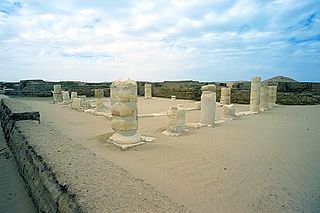
Tebtunis was a city and later town in Lower Egypt. The settlement was founded in approximately 1800 BCE by the Twelfth Dynasty king Amenemhat III. It was located in what is now the village of Tell Umm el-Baragat in the Faiyum Governorate. In Tebtunis there were many Greek and Roman buildings. It was a rich town and was a very important regional center during the Ptolemaic period.

The Faiyum Oasis is a depression or basin in the desert immediately west of the Nile river, 62 miles south of Cairo, Egypt. The extent of the basin area is estimated at between 1,270 km2 (490 mi2) and 1,700 km2 (656 mi2). The basin floor comprises fields watered by a channel of the Nile, the Bahr Yussef, as it drains into a desert hollow to the west of the Nile Valley. The Bahr Yussef veers west through a narrow neck of land north of Ihnasya, between the archaeological sites of El Lahun and Gurob near Hawara; it then branches out, providing agricultural land in the Faiyum basin, draining into the large saltwater Lake Moeris. In prehistory it was a freshwater lake, but is today a saltwater lake. It is a source for tilapia and other fish for the local area.

Ancient Egyptian literature was written in the Egyptian language from ancient Egypt's pharaonic period until the end of Roman domination. It represents the oldest corpus of Egyptian literature. Along with Sumerian literature, it is considered the world's earliest literature.
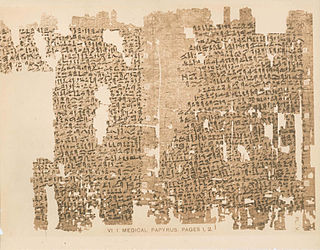
The Kahun Gynaecological Papyrus is the oldest known medical text in Egyptian history, dated to c. 1825 BCE, during the Twelfth Dynasty. The Papyrus addresses gynecological health concerns, pregnancy, fertility, and various treatments.

Medinet Madi, also known simply as Madi or Maadi (ماضي) in Arabic, is a site in the southwestern Faiyum region of Egypt with the remains of a Greco-Roman town where a temple of the cobra-goddess Renenutet was founded during the reigns of Amenemhat III and Amenemhat IV. It was later expanded and embellished during the Greco-Roman period. In the Middle Kingdom the town was called Dja, later the town was known as Narmouti, Narmouthis and Narmuda.

Geb was the Egyptian god of the earth and a mythological member of the Ennead of Heliopolis. He could also be considered a father of snakes. It was believed in ancient Egypt that Geb's laughter created earthquakes and that he allowed crops to grow.
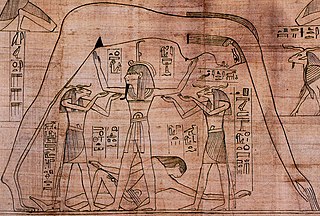
The Greenfield Papyrus is a papyrus that contains an ancient Egyptian Book of the Dead and is named after Mrs. Edith Mary Greenfield, who presented it to the Trustees of the British Museum in May 1910. Now in the collections of the British Museum, London, it is one of the longest papyri in existence with a length of 37 metres.

The Book of Nut is a collection of ancient Egyptian astronomical texts, also covering various mythological subjects. These texts focus on the cycles of the stars of the decans, the movements of the moon, the sun, and the planets, on the sundials, and related matters.

The Theban Tomb TT63 is located in Sheikh Abd el-Qurna. It forms part of the Theban Necropolis, situated on the west bank of the Nile opposite to Luxor.
Sumenu or Smenu was an ancient Egyptian town located in Upper Egypt. It housed the most prominent early-Middle Kingdom sanctuary of the crocodile-god Sobek.
References
- ↑ Klotz, 566.
- ↑ Beinlich, 15 – 26.
- ↑ Tait, 185.
- ↑ Ibid.
- ↑ Ibid., 183 – 184.
- ↑ Beinlich, 27.
- ↑ Ibid.
- ↑ Egypt’s Mysterious Book of the Faiyum. Press Release, The Walters Art Museum, 28-05-2013, http://thewalters.org/news/releases/pressdetail.aspx?e_id=426 Archived 2013-09-03 at the Wayback Machine .
- ↑ Hornung, 27 - 53.
- ↑ O’Connor, 68, 72.
- ↑ Allen, 2 -7.
- ↑ Tait, 185.
- ↑ Ibid., 192.
- ↑ O’Connor 75 – 76.
- ↑ Tait, 201 – 202.
- ↑ Ibid., 185.
- ↑ O’Connor, 70 – 74.
- ↑ Tait, 188 – 195.

